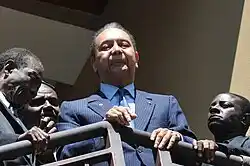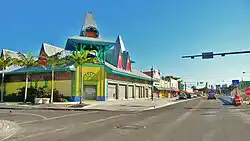The Duvalier dictatorships refers to the period between 1957 and 1986 during which Haiti was controlled by the dictators, François Duvalier and his son, Jean-Claude Duvalier, colloquially known as ‘Papa Doc’ and ‘Baby Doc’. François came to power through a coup in 1957 and ruled down to his death in 1971. He was succeeded by Jean-Claude who remained in power until overthrown in 1986. The regime was notoriously corrupt and incompetent, leading to a huge decline in living standards and economic stability and an increase in disease pandemics and epidemics. This fuelled a wave of migration from Haiti, particularly so in the 1970s and 1980s as people fled on boats for the United States and other parts of the Caribbean. This drove a major increase in the Haitian diaspora during the years of the Duvalier dictatorships, while Haiti has continued to experience political, social and economic problems ever since, ones that fuelled further outward migration.[1]
Research your ancestors on MyHeritage
Duvalier dictatorships chronology of eventsDuvalier dictatorships chronology of events
Haiti is the second oldest nation in the western hemisphere. Only the United States has a longer history as a country free of European colonial rule. The Haitian Revolution began in 1791 and ended in 1804 when Haiti fully freed itself from French control. However, unlike the United States, it has a long history of autocratic rule. In 1804, when independence was fully acquired, one of the Haitian revolutionary leaders, Jean-Jacques Dessalines, established himself as ruler of the First Empire of Haiti. A Second Empire of Haiti was established under Faustin Soulouque in 1849 after an experiment in republican government.[2] This turbulent history continued into the second half of the nineteenth century and early twentieth, including a period of US occupation between 1915 and 1934. Thus, it was not too out of the ordinary when the presidency of François Duvalier, elected as the 34th President of Haiti in 1957 after previous stints as Minister of Labor and Health, gradually became more autocratic in the late 1950s and early 1960s.[3]

If there was a point at which Duvalier’s democratic position became a dictatorship it was during the 1961 presidential election, in which Duvalier was the only candidate on the ballot. Three years later he declared himself to be ‘President for Life’ and held that post until his death in 1971. ‘Papa Doc’ was succeeded by ‘Baby Doc’, his son, Jean-Claude Duvalier, who was just 19 years of age at the time. The second Duvalier dictator proved to be a disaster for Haiti. He was a playboy ruler who delegated day-to-day governance to officials while otherwise living a lavish lifestyle. His interventions largely revolved around autocratic measures to impose censorship and have many people arrested as political prisoners to clamp down on any opposition to the Duvalier family’s rule.[4]
As the 1970s went on and into the 1980s there was growing opposition to the regime and its actions. This was driven by both the dictatorial attitudes of the regime and also a wide range of socio-economic problems which arose during this time. For instance, an outbreak of African swine fever virus in the late 1970s required the government to impose a huge cull of the island’s swine population in the early 1980s, something which aroused enormous discontent within a primarily agricultural country. The HIV/Aids epidemic also ravaged Haiti in the 1980s.[5] As food prices soared, protests against the regime became more common in the mid-1980s. Like all dictatorships, the Duvaliers only fell from power once it became clear that they were losing the support of the police and the army. Once this occurred, and the administration of President Ronald Reagan made it clear that the US, which had formerly supported the Duvalier dictatorship, was unwilling to prop it up any further, ‘Baby Doc’ took the decision to flee from Haiti in February 1986.[6]
The Duvaliers eventually found political asylum in France, the former colonial power. Curiously Jean-Claude decided early in 2011 to return to Haiti after a quarter of a century abroad to try to win election through democratic means there. He was quickly arrested and faced corruption charges which were still pending when he died from a heart attack in October 2014. Haiti had reverted back to a democratic system after he had fled in 1986, but the country has remained troubled, both as a result of natural disasters such as Hurricane Sandy in 2012 and Hurricane Matthew in 2016 and a devastating earthquake in 2010. In recent years political order has collapsed in the country. Thus, the legacy of the Duvalier dictatorships is still alive nearly 40 years on.[7]
Extent of migration associated with the Duvalier dictatorshipsExtent of migration associated with the Duvalier dictatorships
The Duvalier dictatorships saw a steady stream of individuals leaving Haiti to escape either political persecution or economic privation brought about by utter mismanagement of the country’s economy. The pattern began from 1964 onwards after ‘Papa Doc’ made himself President for Life and largely involved the Haitian upper classes early on. The problem of migration became particularly acute from 1972 onwards shortly after ‘Baby Doc’ became dictator of the country. It continued thereafter for the remainder of his rule, involving hundreds of thousands of people in the quarter century between the early 1960s and the end of the dictatorship in 1986. These people largely headed for other parts of the Caribbean and the United States and became known as the ‘Haitian boat people’, a term which consciously imitated the reference to the political refugees from Vietnam in the 1970s as the ‘Vietnamese boat people’. One could argue that the stream of Haitian emigration which has occurred since 1986 down to the present day is also partly the result of the dictatorships, which destabilized Haitian society considerably in ways which still resonate to this day.[8]
Demographic impact of the Duvalier dictatorshipsDemographic impact of the Duvalier dictatorships

The demographic impact of this political and economic migration from Haiti was quite considerable. For instance, there are over one million people of Haitian birth or heritage in the United States today. A very sizeable proportion of these are the ‘Haitian boat people’ who arrived in the 1960s, 1970s and 1980s, or their descendants. These settled in large numbers in Florida, New York, New Jersey, Massachusetts and other parts of the East Coast. They have often formed substantial communities such as Little Haiti in Miami, Florida. Thus, many people in the United States or in several countries elsewhere in the Caribbean will be able to trace their family heritage back to relatives who left Haiti and moved abroad during the era of the Duvalier dictatorships between 1957 and 1986.[9]
See alsoSee also
Explore more about the Duvalier dictatorshipsExplore more about the Duvalier dictatorships
- Instability in Haiti at Council on Foreign Relations
- Haiti Profile - Timeline at BBC News
- Haiti's Rendezvous with History: The Case of Jean-Claude Duvalier at Human Rights Watch
References
- ↑ David Nicholls, ‘Haiti: The Rise and Fall of Duvalierism’, in Third World Quarterly, Vol. 8, No. 4 (October, 1986), pp. 1239–1252.
- ↑ https://elischolar.library.yale.edu/gsas_dissertations/72/
- ↑ https://www.thecrimson.com/article/1963/6/3/the-duvalier-regime-paccording-to-haitis/
- ↑ https://www.hrw.org/report/2011/04/14/haitis-rendezvous-history/case-jean-claude-duvalier
- ↑ https://www.peoplesworld.org/article/when-haitis-dictator-baby-doc-lost-control-it-was-washington-to-the-rescue/
- ↑ https://www.bbc.com/news/world-latin-america-29493170
- ↑ https://www.cfr.org/global-conflict-tracker/conflict/instability-haiti
- ↑ Alex Stepick, ‘Haitian Boat People: A Study in the Conflicting Forces Shaping U.S. Immigration Policy’, in Law and Contemporary Problems, Vol. 45, No. 2, U.S. Immigration Policy (Spring, 1982), pp. 163–196.
- ↑ https://www.migrationpolicy.org/article/haitian-immigrants-united-states-2022

